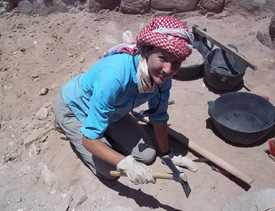posted 2012.12.11
Though most are familiar with the ancient city of Petra’s magnificent temples, tomb facades, and Byzantine churches, little is known about the ordinary citizens of Petra. As part of a team of students and archeologists, Caiti Cremer ‘15 set out to discover more.
The team that Cremer worked with excavated the North Ridge of Petra — one of the Seven Wonders of the World. Their goal was to learn more about the population after the Roman annexation through the Byzantine period — specifically from the 4th-6th centuries.
Cremer spent her summer working alongside experienced archaeologists and Jordanian workers excavating a domestic structure. They were able to date Petra’s city wall, find out about which areas traded with Petra, and learn more about the earthquake of 363 A.D. New insight was gained through an analysis of the architectural, botanical, skeletal, and ceramic remains found in the North Ridge and the other areas of the site.
The team stayed in the small town of Wadi Musa and lived above the home of a local community leader and his family. These living arrangements allowed Cremer to gain new insight into the daily routines of Arabic culture.
“I now have a greater appreciation for relations between cultures,” says Cremer. “During the excavation, it did not matter who was American or who was Jordanian — we were all working toward a common goal.”
Cremer was able to explore areas of Jordan at her leisure that further broadened her perspective on Jordanian culture. When not working, the team was able to visit historic sites in Jordan such as the Dead Sea, the Red Sea, and Wadi Rum.
Cremer hopes to use her new cultural knowledge of the Middle East to encourage fellow NC State students to also become more culturally aware. This experience has made her more appreciative of the value of history and how it is uncovered. Cremer is majoring in chemical engineering and is now considering minoring in international studies or Arabic.
